I invite your commentary and critique on the following essay which caused Faith and Family Findings (FFF) to take some time out for the last few weeks. The implications of one research report sunk in: the human race and its various major cultures have moved beyond a tipping point. Grappling with this took time and the result is the following — a first attempt at a terra firma framework from which to make sense of the present and to use this social-science-based-compass for steering towards a better future. The email to use if you wish to offer your critique is FFFessaycommentary@gmail.com. It will be a great gift to give! Sincerely, Pat Fagan By Patrick F Fagan The world’s fertility rate continues to decline precipitously, with more and more countries falling below replacement levels (2.1) across the developed regions of the world, and bottoming out somewhere in the region of 1.5 (EU) or lower (0.9 for S Korea). With replacement being at 2.1 child per woman the European Union’s (EU’s) emerging cohort three generations hence will be two thirds less than today’s, while South Korea’s nine tenths less! Even in a traditionally Catholic country like Ireland, the total fertility rate has dropped below the fertility rate of France. 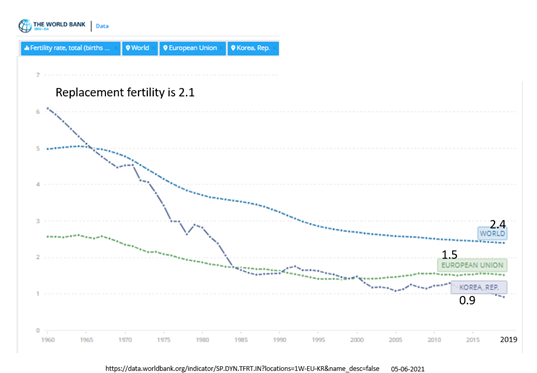 Ireland’s Central Statistics Office recently states “To maintain the current ratio of five workers to one older person in 2051, it is estimated that an additional 4 million migrants would be needed.” In other words, Ireland is hoping to double itself through immigration rather than do the work that marriage is designed for and which Ireland did with ease for centuries. The United States is on the same track.
Ireland’s Central Statistics Office recently states “To maintain the current ratio of five workers to one older person in 2051, it is estimated that an additional 4 million migrants would be needed.” In other words, Ireland is hoping to double itself through immigration rather than do the work that marriage is designed for and which Ireland did with ease for centuries. The United States is on the same track. 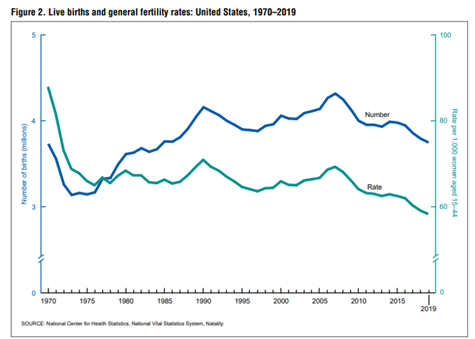 This depletion is most acute in the developed world and it should not take long before young migrants from developing countries figure out how to auction their migration/life contributions to the highest bidding developed nation! Within a generation or so, the developed world’s biggest problem will be a critical shortage of people, and an even greater shortage of those people capable of high productivity and the relational capacity to take care of both the young and the elderly. While technology may increase human productivity to compensate somewhat for the shortfall in workers,[2] the much bigger danger is that mankind’s human and social capital will continue to drop, leading to a “relationship famine” and thus to less family-sustainment, less self-management and less self-governance. The missing ingredient causing this shortfall is the married father.
This depletion is most acute in the developed world and it should not take long before young migrants from developing countries figure out how to auction their migration/life contributions to the highest bidding developed nation! Within a generation or so, the developed world’s biggest problem will be a critical shortage of people, and an even greater shortage of those people capable of high productivity and the relational capacity to take care of both the young and the elderly. While technology may increase human productivity to compensate somewhat for the shortfall in workers,[2] the much bigger danger is that mankind’s human and social capital will continue to drop, leading to a “relationship famine” and thus to less family-sustainment, less self-management and less self-governance. The missing ingredient causing this shortfall is the married father.
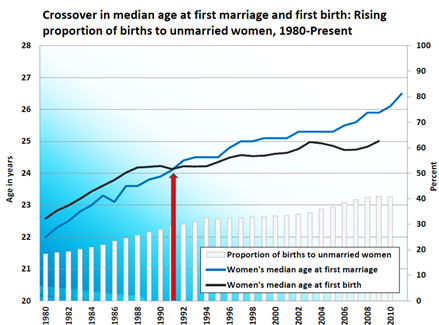
The child of the future, with more parents and grandparents to take care of will need even greater caring capacity than today’s adult whose burden is much less than the future young adult will face. However, rather than investing heavily in the relational capital and wellbeing of our children we are treating them less and less well.
The child is being left more and more alone, and less and less nurtured, as the US Census Bureau acknowledges in its recent announcement[3] of the US’s continuing increase in single parenthood which “ living arrangements can have implications for children’s outcomes, such as academic achievements, internalizing problems (e.g., depression and anxiety), and externalizing problems (e.g., anger and aggression),” none of this being new to readers of Faith and Family Findings.


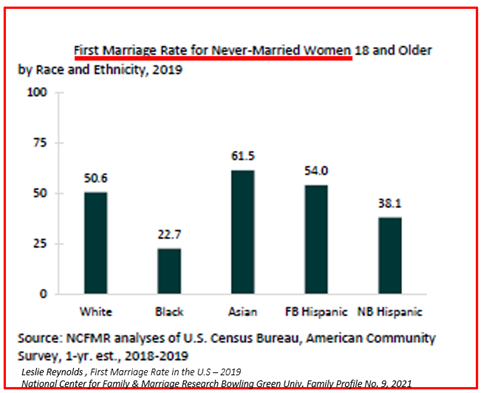
To raise a child well takes an enormous investment of the time and love — by a father and a mother who not only take care of the child, but also take good care of each other and those around them (community) and also take care of God (worship). This is writ large in the social science data — and in common sense observation. This has huge implications for the Black family.
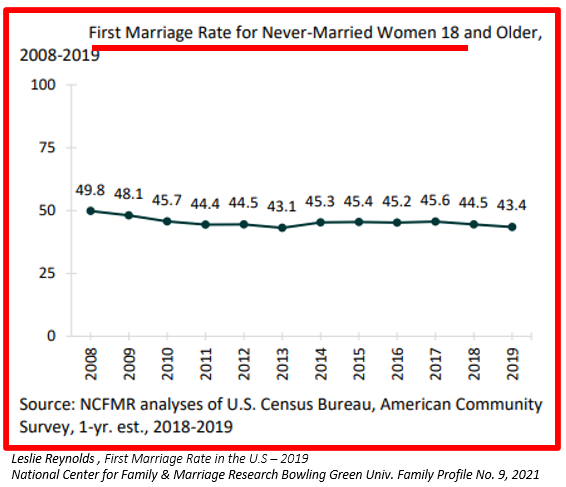
Over the years one of the most striking instances of ignoring this collapse, especially within the Black family, occurred within the often-amazing work of the Upshot Project of the New York Times when it dynamically illustrated the upward and downward mobility of different US ethnic groups but which left out marital data (very deliberately I think) which quickly explains why Black men rise less and fall more[4] in their income levels. No ethnic group has abandoned marriage more than have Black Americans.[5] Yet Black Americans have the highest rate of weekly church attendance.
How did this disconnect between births, marriage and worship take place?
The answer lies outside what is being observed, — from outside sociology and the social sciences, as physics leaned some time ago, in the discovery of the principle of the detached observer (the Heisenberg principal[6]). For such an “outside observer or platform” a good fit is Joseph Ratzinger (the later Pope Benedict XVI), a major actor on the world stage since the late 1950’s and a continuous commentator on the state of humanity and the church.[7] Sociological practice justifies such an observer/spokesman because in sociology Catholics are often taken as the occupants of one end of “of the fertility bell curve” and because Catholic practices are often taken as the “sacralized pole” opposite the “secularized pole” of beliefs and practices.
In 1958, a young professor of theology Joseph Ratzinger wrote a paper “The New Pagans and the Church”, which was startling for its time. In it he fingered the secularization[8] within the Catholic Church:
The outward shape of the modern Church is determined essentially by the fact that in a totally new way, she has become the Church of pagans, and is constantly becoming even more so. She is no longer, as she once was, a Church composed of pagans who have become Christians but a Church of pagans, who still call themselves Christians, but actually have become pagans…. And there can be no doubt that most of them, from the Christian point of view, should really no longer be called believers, because they follow, more or less, a secular philosophy.
In other words, for Ratzinger and for sociologists, the two are on opposite ends of the spectrum of values-beliefs-practices.
In 1968 Pope Paul VI issued Humanae Vitae, a publication which reaffirmed the perennial Christian teaching on contraception dating back to Apostolic times. This document, brought into the open the secularization-sacralization split in the church.[9] The predictions of the effects of contraception enumerated by Paul VI with the encyclical give it, because of its predictive validity, Nobel Laureate status in science. It remains an embarrassment within the social sciences to this day.
In 1969, the then more widely known Professor Ratzinger predicted a much smaller church.
In 1972 Pope Paul VI, known to have been stricken by the response of so many to Humanae Vitae, gave his “Smoke of Satan within the Church” speech, his own version of Ratzinger’s “pagans in the church” speech. For both, the sexual turned pagan is at the core of the secularization of the Church.
In 2021 a majority of the German bishops have backed documents that teach radical departures from Church moral teaching on sexuality.[9.5]
Though Ratzinger made the case about the Catholic Church he has to have his counterparts in Protestantism, Judaism, and other natural law religions. For Hinduism Gandhi comes to mind.[10]
These rather public arguments within the Catholic Church clearly illustrated the same competition and process underway across all societies: the competition between the way of secularization and the way of sacralization. Within the church and all religions and denominations, competition over sexual norms continues to occupy center stage, shaping choices, habits, political parties, cultures, and denominations by shaping attitudes regarding sexual intercourse, the life of the child, the marriage of the couple, the family they are bring into existence, the community they are shaping and even the very existence of societies.
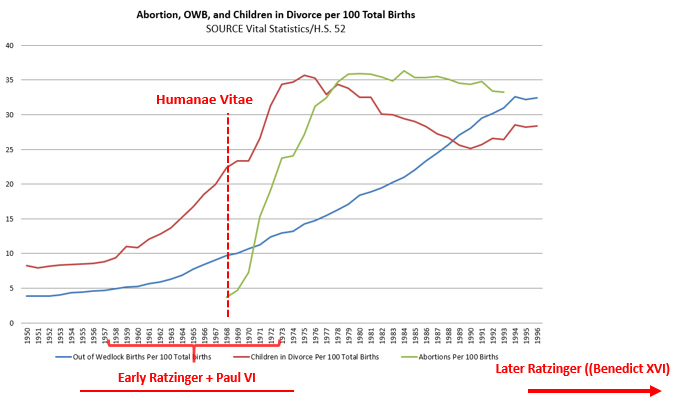
Contraception, more than any other issue — more even than abortion —- is the great ‘desacralizer’ of everything to do with matters sexual: romance, babies, marriage, vows, divorce, cohabitation, and abortion. As the timeline of the US Supreme Court’s decisions on matters sexual also show, it was contraception that led the way to secularization,[11] and a speedy de-sacralization of sexual intimacy, of family life and of community life by which the worship of God was pushed to the sidelines — as recent Pew Research Center data on worship and affiliation illustrate yet again.[11.5]
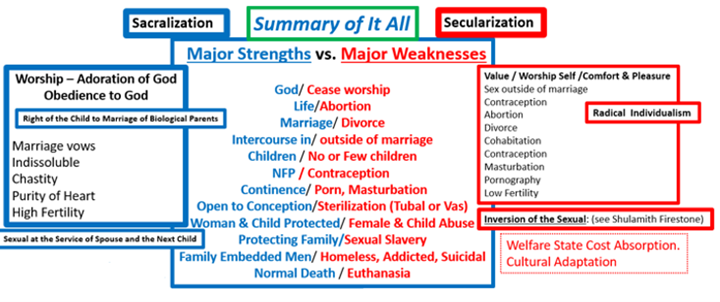
With these secularization processes already well established across the developed world, the contrast in birthrates between the secularized end of society and the still sacralized opposite is strikingly clear. Nothing else, comes close in explaining and predicting rates of fertility![12] This holds across nations, cultures, and religions. The more that women worship the more children they bring into existence.
The impact of secularization is even more alarming because recent research shows that as many as 80 percent of young women view marriage as an option, and not as a goal.[13] In other words, these future mothers are comfortable with the possibility of their children growing up without a father and are at ease with out-of-wedlock sexual intercourse and out-of-wedlock births. The remaining 20 percent plan to have their children within marriage.
The Embarrassing Solution:
Re-sacralization
Despite these secularization processes being underway worldwide, the contrast in birth rates between secularized societies and the still sacralized societies is strikingly. Nothing else comes close in explaining and predicting rates of fertility![14] This holds across nations, cultures, and religions. The more that women worship the more children they bring into existence, even highly educated women in France and the UK![15]
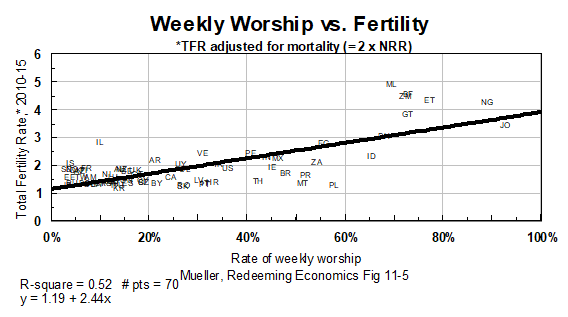
If secularization leads to wilting human relationships the re-sacralization of society beckons as the rebuilder in both the number of persons and their capacity to care and belong to others. The data repeatedly makes this case. It is simply yet powerfully illustrated in the Mapping America Project. There the always-intact-married-family that worships God weekly is the greatest generator of all things good for both adults and children. This holds for all races and income groups on all outcomes measured in the US federal data system. When man and God embrace in worship, man thrives.
So, the data show — even to those who do not believe in God. The more secularized people become (dropping worship or marriage or both) the weaker the results for adults and children. This is so clear in the average data is seems like an iron law or a fundamental principle of human development.
Thus, the sacralization of family relationships leads to compounding growth in human flourishing across generations, while desacralization leads to compounding depletion. Though material benefits buffer the depletion they do not eliminate it, most especially on the sine-qua-non of population replacement by which a society, literally, lives or dies.
Thus, it seems rather clear that:
- The world is increasingly facing a shortage of people.
- The young people the developed West is raising are less and less relationally-capable.
A ‘turn-around’ is urgently needed and sacralization is the way.
Therefore, those who can effectively re-sacralize individuals, couples, families, and communities are the most needed and most valuable human capital a society can have.
How to find these and “grow” them is every developed societies biggest challenge, because even to suggest this solution in the media of public discourse on social policy would be virtually impossible. Getting to the point of engaging society at large would be to have gained immense ground. The first step is to get those who worship regularly to discuss this and to find such people among them and then to support them in getting educated and formed. These are the leaders in sacralizing and re-sacralizing those who want it.
——
Your critique is appreciated,
Sincerely,
Pat Fagan
FFFessaycommentary@gmail.com
[1] Faith and Family Findings (FFF) took time out for the last few weeks as the implications of one research report sunk in: the human race and its various major cultures have moved beyond a tipping point. The following is a first attempt at a terra firma framework from which to make sense of the present and to use this social science based compass for steering towards a better future.
[2] World poverty is likely to be eliminated within the next decade, See: https://data.worldbank.org/topic/poverty?most_recent_value_desc=false
[3] Announced rather “merrily” if the photo theme is indicative:
[4] https://marri.us/wp-content/uploads/June-29-2018-PFF.pdf
[5] See The Fifth Annual Index of Family Belonging and Rejection,
[6] See especially the section on Heisenberg’s microscope.
[7] When these demographic shifts began to take place.
[8] He called it the ‘paganization’.
[9] Made visible by the many national bishop assemblies which undermined the reception of the encyclical with their ambivalence while enabling a “private interpretation of natural law” — a veiled form of revolt against the encyclical.
[9.5] See: https://en.wikipedia.org/wiki/Synodal_Path and https://www.catholicworldreport.com/2021/04/28/cardinal-pell-the-duty-of-the-german-bishops-is-to-uphold-the-teachings-of-scripture-2/
[10] Ghandi’s critique of the effects of contraception closely parallels Paul VI’s
[11] Griswold v. Connecticut, 381 U.S. 479 (1965) and Eisenstadt v. Baird, 405 U.S. 438 (1972)
[11.5] See: https://www.pewresearch.org/catholic-attendance/ and https://www.pewforum.org/2019/10/17/in-u-s-decline-of-christianity-continues-at-rapid-pace/
[12] John Mueller “Redeeming Economics” 2014, chapter 11, figure 5
[13] Shepherd and Marshall (2019) “Childbearing Worldviews and Contraceptive Behavior Among Young Women.” This report, not from national data but Michigan data, is cause for alarm (and further, deeper study) because Michigan is considered a “median” state by family demographers, so the US is likely to be close to the same.
[14] John Mueller “Redeeming Economics” 2014, chapter 11, figure 5
[15] Nitzan Peri Rotem, Fertility differences by education in Britain and France: The role of religion. Population Volume 75, Issue 1, January 2020, pages 9 to 36.
